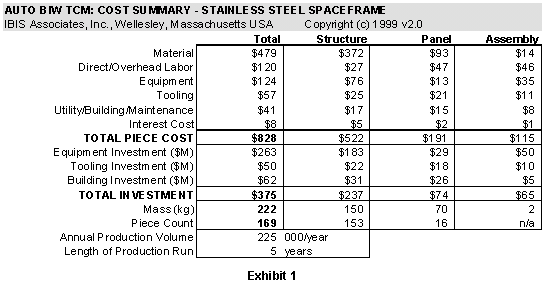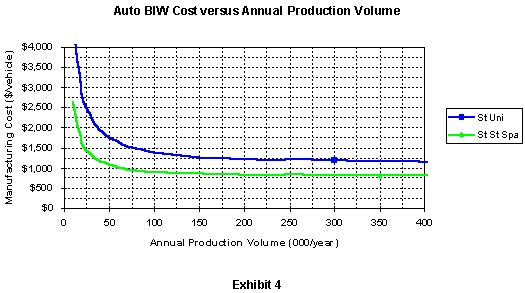|
International Body Engineering Conference
1999 Conference and Exhibition October, Detroit Not the Delorean Revisited:
|
|
ABSTRACT
Autokinetics is a Rochester Hills MI design firm working with Armco, a supplier of stainless steel. Together, they have developed an architecture that replaces the traditional stamped and spot welded steel unibody with a novel stainless steel spaceframe architecture.
Relative to conventional steel unibodies, the Autokinetics spaceframe architecture offers a number of projected advantages.
The obvious question that arises, and the one that this paper will answer, is: How does the Autokinetics spaceframe architecture compete on cost? |
|
INTRODUCTION
The dominance of carbon steel in the automobile body-in-white is near-total: approximately 99.97% of global passenger vehicles are manufactured from this material system. An obvious question arises, of course: "What does the other 0.03% know, or think that it knows?" The second leading body architecture is the aluminum spaceframe in the form of the Audi A8, accounting for most of the remaining 0.03%. After the A8, the only other production architectures are ultra-low volume high-end vehicles such as the aluminum Acura NSX, Plymouth Prowler, and GM EV1, and the hybrid steel-composite Lotus Elise. Two primary forces drive challenges to the conventional steel unibody: performance and cost. On the performance side, mass reduction is currently the strongest of these drivers due to its impact on fuel economy and emissions. To date, the approaches that promise mass reduction do so at a cost premium, however, and have therefore not been widely adopted. One new body structure approach that promises to offer both mass and cost reduction is the stainless steel Autokinetics spaceframe architecture. This paper assesses the potential manufacturing cost advantage for the stainless steel spaceframe compared with a conventional steel unibody in the following areas.
|
|
TECHNICAL COST MODELING
To understand manufacturing cost, IBIS employs an approach called Technical Cost Modeling. The technique [1] is an extension of conventional process modeling, with particular emphasis on capturing the cost implications of material and process variables and changing economic scenarios. Technical Cost Models (TCM) consist of two elements: a framework of algorithms or equations, and the data that fills this framework. The following steps characterize a cost modeling exercise.
The goal of Technical Cost Modeling is to understand the costs of a product and how these costs are likely to change with changes to the product and process. Specifically, this includes the breaking down and ranking of cost into its constituent elements as listed below.
Once these costs are established, sensitivity analysis can be performed to understand the impact of changes to key parameters. IBIS has applied this methodology repeatedly for a broad range of automotive applications. This paper is an updated and much more detailed analysis of the stainless steel spaceframe first evaluated previously [2]. |
|
CASE STUDY DEFINITION
This section describes the case study comparison between the steel unibody and the stainless steel spaceframe. The baseline comparison assumes that both designs include a conventional exterior panel set stamped from carbon steel. The steel unibody is painted in conventional fashion, whereas the stainless steel spaceframe assumes paint for the exterior panels only. Variations on these assumptions are also considered. A number of assumptions are common to both cases.
Basic design details for the two cases are as follows (note that the roof is included in the structure, and that the panel count includes inners and outers). 
The list below shows the materials for the two case studies.
In addition to stamped steel panels, four other panel set variations are considered.
It is assumed that the steel and SMC panels are conventionally painted, and that the injection molded panels are molded-in-color. It should be noted that molded-in-color technology is not standard today, nor is the ability to use injection molded thermoplastic for horizontal panels. There are rapid developments, however, that will potentially make both viable in the one to five year timeframe. The panel set variations give rise to a set of paint variations as well, listed from most to least paint intensive.
|
|
RESULTS AND ANALYSIS
|
|
Exhibit 1
The first part of the results and analysis section presents the details of the stainless steel spaceframe manufacturing cost. These costs are then compared to the steel unibody. Exhibit 1 shows the detailed cost breakdown for the stainless steel spaceframe (including exterior panels, but excluding paint). 
|
|
Exhibit 2
Exhibit 2 shows the impact of selecting various panel and paint alternatives to accompany the stainless steel spaceframe structure. For each case, the table shows mass, piece count, paint type, cost per vehicle, and investment cost. The latter two are broken down by structure, panels, assembly, and paint. 
The first case (“Steel”) is for stamped steel panels that are conventionally painted (panel set 1, paint option D). The cost per vehicle is shown to be $1,142 on a $647 million investment. Note that this investment as well as those throughout the analysis are “greenfield,” meaning that they assume that new equipment, tools, and building space are purchased and allocated over the production run in question. The second case (“SMC”) assumes that painted SMC panels replace steel (panel set 2, paint option D). The slight per vehicle and investment cost increase reflects the higher cost for SMC panels versus steel at high volume (225,000 vehicles per year; SMC becomes less expensive than steel below about 100,000 vehicles per year as modeled in the current analysis). The Steel-TP and SMC-TP cases (panel set 3/paint option E and panel set 4/paint option E) add still more cost, respectively, although each reduces the investment due to the smaller paint facility necessary to paint only the horizontal and inner panels. Finally, the Thermoplastic case (panel set 5/paint option F) shows the lowest cost per vehicle and investment cost. It is necessary to reiterate, however, that this case represents technology not currently available: namely, molded-in-color thermoplastics for vertical and horizontal surfaces. At the same time, this result shows the strong motivation for developing such technology. |
|
Exhibit 3
Exhibit 3 shows how the cost of the stainless steel spaceframe (again, including exterior panels but exclusive of paint) varies as a function of annual production volume. The drop in cost as volume increases is due to the spread of dedicated investments such as tooling and assembly over larger numbers of units. Economies of scale are reached at about 100,000 vehicles per year. 
|
|
Stainless steel spaceframe vs. steel unibody
The stainless steel spaceframe is found to have a cost advantage of about $375 (23%) if paint is not included, and $475 (30%) if paint is included. 
If thermoplastic panels are used for the stainless steel spaceframe, the cost advantage widens to 40%. Even if assembly for the stainless steel spaceframe is low by a factor of three, a cost savings still results. Moreover, the assumed material price for stainless steel is on the conservative (high) side, ranging from $2.20 to $2.53 per kg ($1.00 to $1.15 per pound). A key reason for the finding shown in the table above is the cost of materials in both cases.
In short, the higher material price for the stainless materials is offset by lower mass and lower scrap. |
|
Exhibit 4
Exhibit 4 shows how manufacturing cost for the steel unibody and stainless steel spaceframe vary as a function of annual production volume. It can clearly be seen that the advantage for the stainless steel spaceframe exists not only for high volume, but that this advantage grows as the volume decreases. 
|
|
CONCLUSIONS
The stainless steel spaceframe promises improvements over the conventional steel spaceframe in a number of performance areas: mass, safety, ride and NVH, packaging, paint, and lifecycle impact. If cost were no object, of course, there are other material systems that offer the same, including aluminum, polymer composites, and even carbon steel. On a cost basis, the stainless steel spaceframe architecture developed by Autokinetics and Armco outshines these other material systems as well as the baseline steel unibody. As was stated in the introduction, the two primary drivers for body structures are mass and cost. On paper, depending upon the selection of an exterior panel and accompanying paint scenario, the stainless steel spaceframes demonstrates outstanding improvements for both.
In particular, the cost reduction shows that a higher price, higher performance material can be designed for in a manner that neutralizes the material price premium while allowing manufacturing benefits in fabrication, assembly, and paint. The advantages above are the result of an integrated use of design, materials, and manufacturing. At minimum, these advantages compel the competitive automaker to examine the Autokinetics spaceframe architecture in detail with an eye towards prototype, low volume, and ultimately high volume production. |
|
REFERENCES
[1] John V. Busch, Technical Cost Modeling of Plastics Fabrication Processes, Ph.D. Thesis, Massachusetts Institute of Technology, Cambridge MA, 1987. back [2] Jeff R. Dieffenbach and J. Bruce Emmons (Autokinetics), "A Manufacturing Cost Analysis of Tube and Node Steel Spaceframes," 1994 Society of Automotive Engineers International Congress, Warrendale PA, February 1994. back [3] Jeff R. Dieffenbach, Paul D. Palmer, and Anthony E. Mascarin, "Making the PNGV Supercar a Reality With Carbon Fiber: Pragmatic Goal or Pipe Dream?," 1996 Society of Automotive Engineers International Congress, Warrendale PA, February 1996. back [4] John V. Busch and Jeff R. Dieffenbach, "Economic Criteria for Sensible Selection of Body Panel Materials," 1991 Society of Automotive Engineers International Congress, Warrendale PA, February 1991. back [5] Jeff R. Dieffenbach and Andrew Sokol (Sokol Enterprises), "Solventborne Painting of a Steel Autobody: A Manufacturing Cost Analysis of Conventional and UV Bake Curing," 1995 Society of Automotive Engineers International Congress, Warrendale PA, February 1995. back [6] Jeff R. Dieffenbach, Anthony E. Mascarin, and Michael M. Fisher (SPI), "The Automobile Recycling Infrastructure: Process Cost Simulation," 1993 Society of Automotive Engineers International Congress, Warrendale PA, February 1993. back |